5 Digital-Strategy Questions C-Suite Must Answer to Be Effective
For CFOs to be effective enablers of digital strategy, they must stay true to their organization’s goals and ambitions. Continually asking these five basic questions can help.
This is a republication of the article “5 Digital-Strategy Questions CFOs Must Answer to Be Effective”, with the title above.
Gartner
Contributor: Jackie Wiles
August 12, 2021
Site editor:
Joaquim Cardoso MSc.
The Health Transformation — Multidisciplinary Institute
Digital Health Institute
August 25, 2022
Executive Summary:
What is the problem?
- Pressure is on CFOs to prioritize and fund digital initiatives as organizations reconfigure business and operating models and adapt to new, often-hybrid working environments.
What is needed?
- But to make good digital decisions, you need a clear view of what the digital strategy is and does …
- and that north star can easily get lost amid the furious, often-competing demands for resources.
- “To guard against misplaced digital spend and poor returns on investment later, it’s wise for CFOs to dissect their organization’s digital strategy — and keep verifying it continually,” says Randeep Rathindran, VP, Gartner.
What is the opportunity?
- As the pandemic has sped up digital transformation, making it harder to keep track of the expected goals and outcomes of digital strategy,
- it’s also created an ideal time for CFOs to ask these five questions that together ensure you’re directing resources to those initiatives most likely to enable the enterprise’s ambitions.
What are the 5 key questions?
- №1: What does digital mean to our organization?
- №2: Are we focused on digital transformation or digital optimization?
- №3: What is our optimal mix of digital transformation and optimization?
- №4: What are the costs and benefits of digital optimization?
- №5: What are the costs and benefits of digital transformation?
ORIGINAL PUBLICATION (full version)
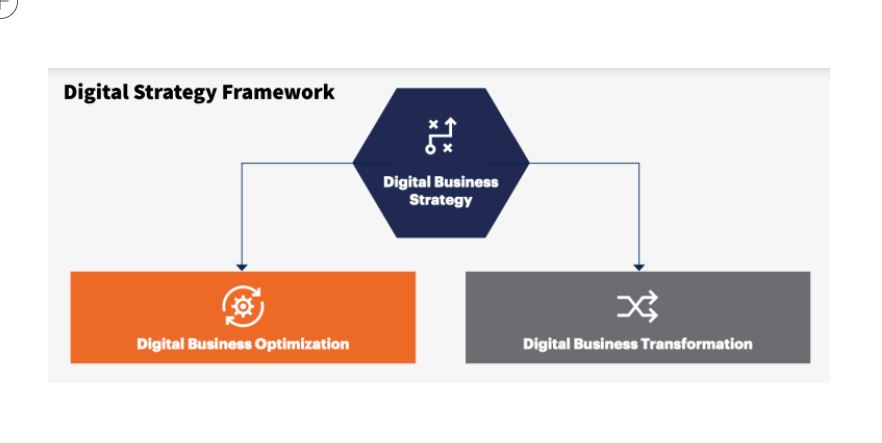
№1: What does digital mean to our organization?
Digitalization generally describes the use of digital technologies to upgrade organizational processes, improve interactions between people, organizations and things, or make new business models possible.
But every organization has different goals and ambitions, and as CFO, you can’t prioritize investment choices without first knowing the tangible outcomes that your organization expects from its digital strategy.
In short, what is the organization trying to achieve, and how will it accomplish those goals?
The answer will help you gauge the climate for digital investments and prioritize initiatives accordingly.
A 2020 Gartner survey found that 69% of boards of directors were responding to the impact of COVID-19 by accelerating their digital business initiatives and strategies.
It also showed boards expecting a 6.9% increase in IT/technology budgets.
CFOs need to understand how to deploy that spend to drive enterprise wide digital strategies and business outcomes.

№2: Are we focused on digital transformation or digital optimization?
“ Digital” isn’t a monolithic strategy, and it’s critical to distinguish between objectives:
- Digital business transformation changes business models or product and service offerings.
It radically shifts the way an organization delivers value to customers or the segments it serves.
Wholesale enterprise business model change is rare; transformation typically happens only in one piece of the business at any given time, depending on where opportunities exist.
- Digital optimization improves existing operations and business models.
The business model — how you’re creating value — remains the same, but how the organization operates changes.
For example, you digitalize key capabilities required to deliver on your business proposition or profit model.
Near-term optimization can be a building block for transformation later.
In strategy discussions and when considering funding requests, CFOs play an important role in verifying whether initiatives support the stated strategy, imposing appropriate metrics and hurdles to trigger or deny spend, and later tracking the success and progress of funded initiatives.
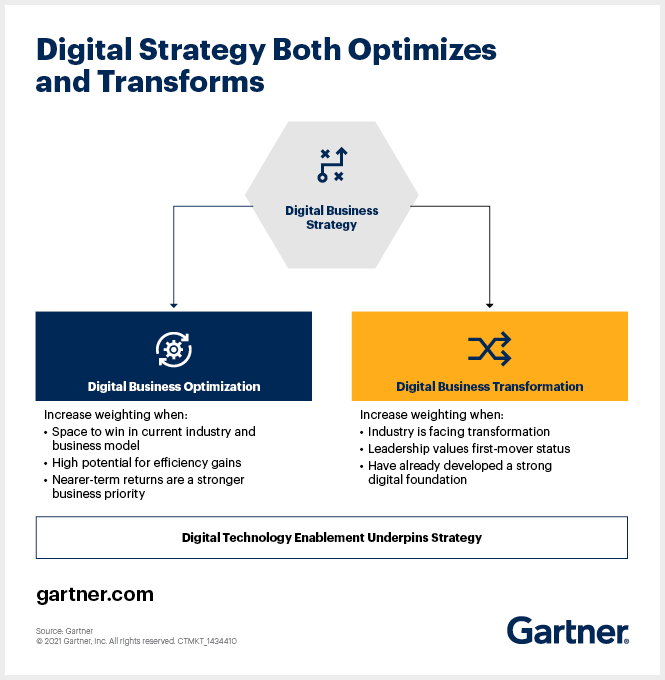
№3: What is our optimal mix of digital transformation and optimization?
The digital strategy of most organizations calls for a combination of transformation- and optimization-oriented outcomes, but that mix depends entirely on your objectives.
Gartner research shows that in 2020, the average organization dedicated 37% of all spend on digital initiatives to optimization, 29% to transformation and 35% to enablement that serves both goals.
As CFO, it is your responsibility to appropriately deploy digital funding to drive the strategy.
Gartner research shows that in 2020, the average organization dedicated 37% of all spend on digital initiatives to optimization, 29% to transformation and 35% to enablement that serves both goals.
The digital strategy of most organizations calls for a combination of transformation- and optimization-oriented outcomes, but that mix depends entirely on your objectives.
In times of transition, for example, you might dedicate more resources to bold, transformative strategic moves, which carry higher risk — and require risk appetite from senior leadership.
You can capture more significant near-term gains from digital optimization, which carries less risk but only enables the existing business model and thus isn’t designed to generate new revenue streams.
You can capture more significant near-term gains from digital optimization, which carries less risk but only enables the existing business model and thus isn’t designed to generate new revenue streams.
Your digital strategy also determines whether the enterprise budget for digital initiatives is growing — and if and how resource priorities should shift between optimization and transformation.
Dynamically shifting funds between initiatives is a hallmark of an effective digital CFO.

№4: What are the costs and benefits of digital optimization?
Digital business optimization targets performance improvements, such as increased revenue and operating margins, improved employee and customer experience and greater asset utilization.
CFOs must be able to calibrate the right balance of outcomes and ensure that all digital spend contributes to these desired outcomes.
One way to do that is to focus resources on areas of differentiation for the business.
Differentiators can relate to intangibles, such as unique intellectual property, or tangible assets, such as proprietary technologies.
The CFO’s role is to ensure that investment and funding for these and other types of high-value initiatives aren’t choked out by activities that don’t contribute to strategic digital outcomes.
It’s also important to determine the key performance indicators (KPIs) that clearly track both digital progress and the expected business and financial outcomes.

№5: What are the costs and benefits of digital transformation?
Digital business transformation is a radical shift — it pushes an enterprise beyond its current business model — so it is most appropriate when a business unit’s or organization’s operating environment is changing.
At its most extreme, digital business transformation moves enterprises into entirely new industries.
Digital business transformation is a radical shift — it pushes an enterprise beyond its current business model — so it is most appropriate when a business unit’s or organization’s operating environment is changing.
Your role is to identify the highest-priority opportunities for digital business transformation based on which transformation options have the highest potential to create revenue and support strong future revenue growth.
Digitally native companies, which have built their products and models from the ground up, offer some lessons here:
- Focus on customer economics and operating leverage when assessing transformation opportunities in new product areas or forms of business models. Successful digital business transformation initiatives are characterized by larger operating margins, where the incremental costs to produce a product or service is much lower than the incremental revenue it generates. Operating leverage eventually drives margin improvements and improves unit economics at scale.
- Ask how digital business transformation helps decrease customer acquisition costs or increase customer lifetime value. For a new business model or product to be viable, customer lifetime value must be higher than customer acquisition cost.
- Reinvest any cost savings into technologies that improve operating leverage, and thus revenue outcomes.
- Prioritize revenue growth and customer acquisition above profits until you achieve scale.
- Ease barriers around payback periods or profitability to ensure that transformation efforts have enough time to reach the scale necessary to be successful and don’t get defunded prematurely.
Originally published at https://www.gartner.com.
Names mentioned
Randeep Rathindran, VP, Gartner.
APPENDIX: Digital Strategy Framework
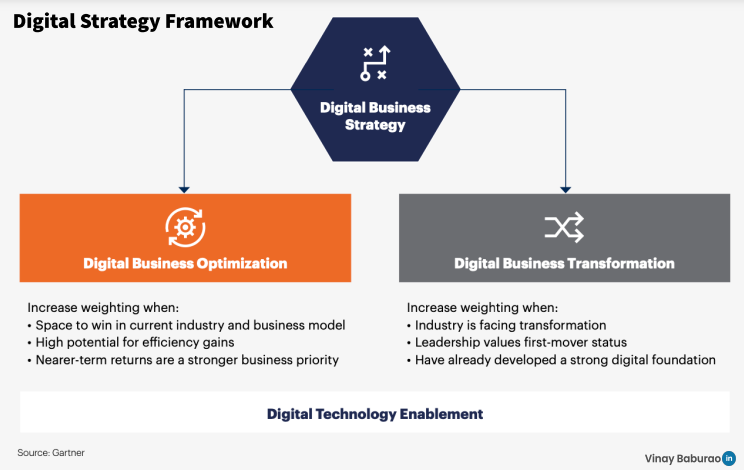
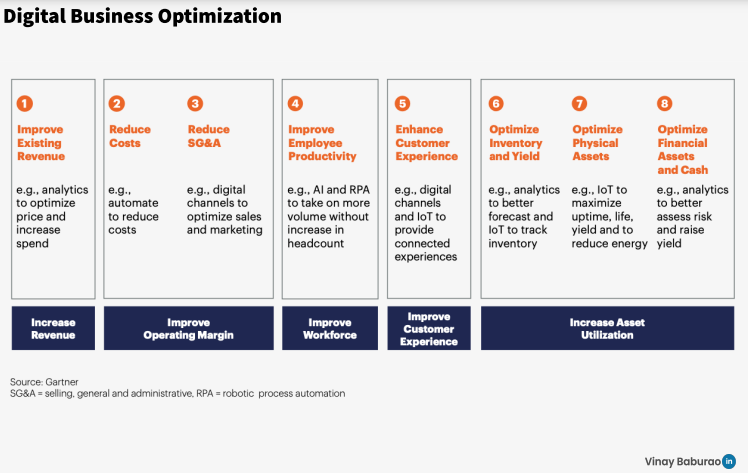

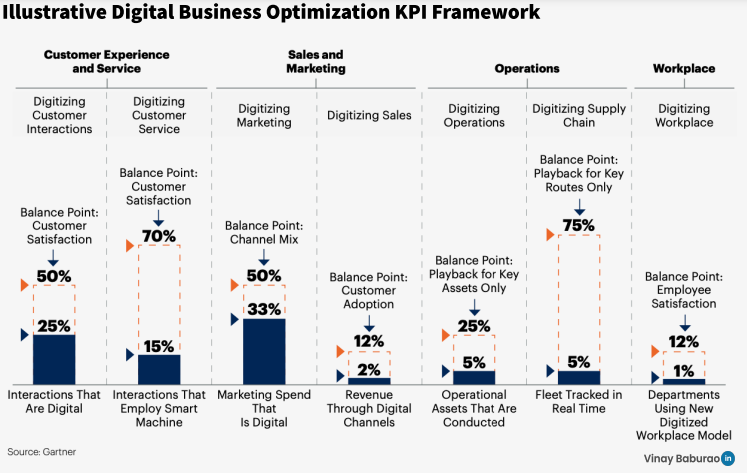
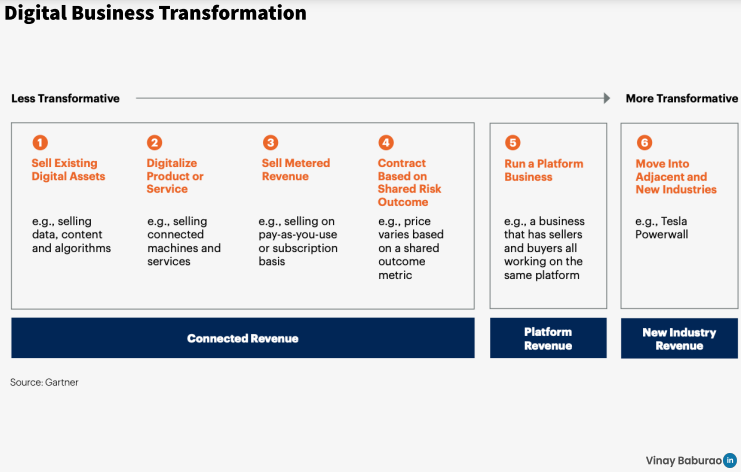
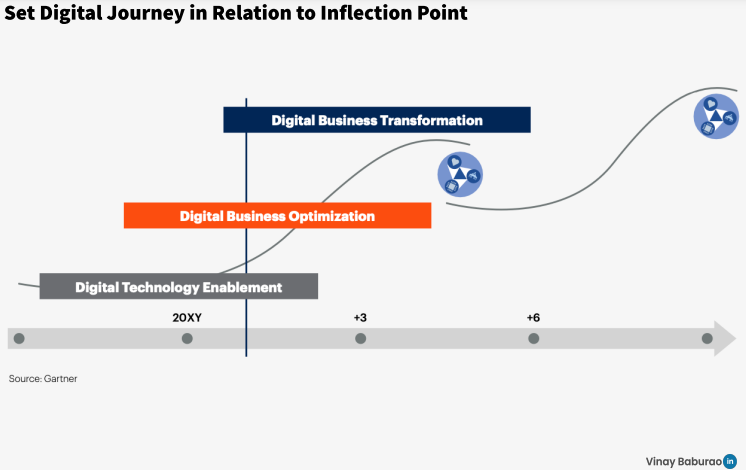
Originally published at gartner.com












